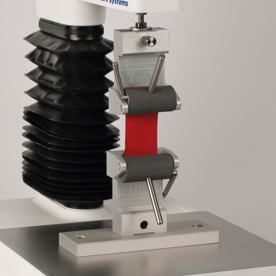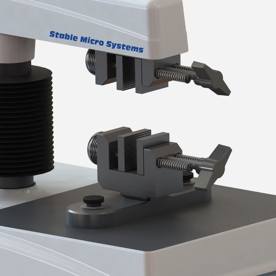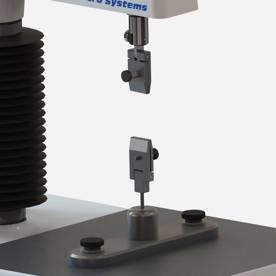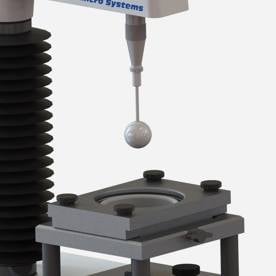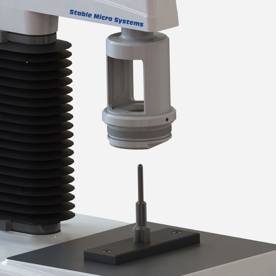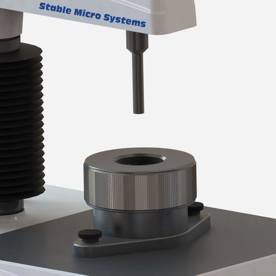
Tensile testing
Learn about tensile testing, when to use this test type and the typical probes and attachments for use on a Texture Analyser.




What is a tensile test?
A tensile test measures how a sample behaves when stretched, revealing its strength, elongation, and flexibility. During testing, a Texture Analyser or materials testing instrument applies a pulling force until the sample deforms or breaks. The instrument records the force and distance to generate a stress-strain or force-distance curve.
From this curve, key mechanical properties such as tensile strength, elongation at break, Young’s Modulus, yield point, and extensibility can be derived-helping characterise how materials respond under tension.
How a Texture Analyser performs a tensile test
The Texture Analyser applies a controlled pulling force between two grips or fixtures while continuously recording force vs. distance. The resulting curve shows how the sample stretches and when it fails. This data allows direct comparison of materials’ tensile strength, elasticity, and extensibility.
Typical graph produced and properties measured
Tensile testing provides quantitative data on how a material resists and responds to stretching, including:
- Tensile strength - Maximum force sustained before fracture
- Yield point - Transition from elastic to plastic deformation
- Extensibility - Ability to stretch without breaking
- Toughness - Total energy absorbed before fracture (area under the curve)
Single or multiple parameters such as peak force, yield point, elongation at break, work of tension and Young's modulus can be collected from the graph. Understanding these parameters allows direct comparison between samples or production batches.
To learn more about how these properties are measured, visit our Textural Properties page.
Types of tensile test
Uniaxial tests
The simplest method of tensile testing is when the specimen comes in an elongated shape (either rectangular or circular in cross-section) or from which reproducible test beams can be cut. The specimen is gripped at either end and stretched until it breaks using Tensile Grips. This is uniaxial tension and is the basis of many Standard ISO or ASTM Test Methods for materials testing (e.g., ASTM D882 for thin plastic films). With the development of new materials, there are often instances where a standard method is not available or where the sample cannot be prepared in the manner in which a standard method stipulates. A standard method might also not be available for the tensile property that is required to measure.
Biaxial tests
Another approach is to perform a bi-axial tensile test where the sample is held like a circular drum skin and stretched in all directions by forcing a ball probe through the centre. This type of testing is popular for testing films and certain foods e.g. tortillas where the measurement of burst strength is required. Whilst clamping a specimen for tensile tests may present difficulties, these can often be overcome by careful choice of the clamping attachment.
Adhesion under tension
Tensile tests are also used to measure the adhesion of a food to a surface. In this type of test the sample has a probe pressed onto it after which the force required to pull it off is measured (see Adhesion for further information).
Choosing a grip / attachment for sample measurement
Accurate tensile data depends on securely gripping the specimen without slippage or premature failure. Stable Micro Systems offers a comprehensive range of tensile fixtures.
Uniaxial tensile testing
Biaxial tensile testing
|
Attachment type |
Typical use |
Notes |
|
Standard / Self-Tightening / Pneumatic Grips |
Films, fibres, packaging materials |
General tensile gripping; choose face/pressure to stop slip without cutting the sample. |
|
Miniature or Articulated Grips |
Small or irregular-shaped samples |
For tiny/awkward samples; self-aligning design reduces off-axis bending errors. |
|
Cheese and Dough Extensibility Rigs |
Measure stretch and elasticity in soft foods |
Imitative stretch test; control prep, temperature, and speed for comparable elasticity results. |
|
Film Support or Burst Rigs |
Packaging films and thin membranes |
Clamped-film puncture/burst test; ensure even, wrinkle-free mounting and correct probe choice. |
|
Ring Pull and Stitch Line Jigs |
Seal, tear, or perforation strength in packaging |
Feature-specific tear/seal test; align pull with seam/perforation and keep start point consistent. |
|
Noodle / Pasta Loop Rigs |
Assess extensibility of pasta strands or noodles |
Loop loading prevents grip damage; standardise loop size and hydration/cook state. |
Materials and bespoke attachments
Bespoke geometries or materials can be produced to customer specification for specialised tests.
Sample presentation and attachment choice
Proper sample handling ensures reproducible tensile results:
- Sample geometry: Cut consistent strips, dumbbell shapes, or loops according to standard dimensions.
- Clamping zone: Reinforce or freeze sample ends to prevent grip slippage or edge tearing.
- Alignment: Mount the sample centrally and vertically to ensure even loading.
- Gauge length: Set consistent initial distance between grips.
- Surface condition: Avoid nicks or pre-damage that could trigger early fracture.
- Environmental control: Test temperature and humidity affect elasticity – maintain consistency for comparisons.
Use cases by industry
|
Industry |
Typical samples |
Measured properties |
|
Food |
Cheese, dough, noodles, gels |
Stretchiness, extensibility, elasticity |
|
Packaging |
Plastic films, paperboard |
Tensile and burst strength |
|
Cosmetics / Pharmaceuticals |
Gel capsules, film coatings |
Tensile integrity, elasticity |
|
Adhesives / Industrial |
Glues, sealants, elastomers |
Peel strength, cohesion, resilience |
Example standard methods using a tensile test
- AFERA 5004 International harmonised test method - Test method for breaking strength and elongation of pressure-sensitive tape (EN 14410:2003)
- ASTM D2209 Tensile measurement of leather
- ASTM D4987 Standard test method for tensile breaking strength of perforations in one-part continuous forms paper
- ASTM D828 Tensile test of paper and paperboard, according to ASTM International test method
- ASTM D882-02 Tensile test of thin plastic sheeting (thickness<1mm)
- ISO 3781 Standard test method for paper and board - Determination of tensile strength after immersion in water
- ISO 3376 Tensile measurement of leather
- ISO 3378 Lastometer or Ball Burst Test
What else do I need to perform a tensile test?




Probe Adapters
Probe adapters securely mount and align probes on the Texture Analyser. Magnetic and quick-twist options allow quick, repeatable changeovers, boosting throughput when swapping different probes or running multiple tests.

Heavy Duty Platform
For biaxial tests, if required.

Calibrated Load Cell
Ensure measurement within correct force range.

Temperature control
For the testing of temperature sensitive samples.
More examples of how a Texture Analyser performs tensile tests
People also ask
What does a tensile test measure?
It measures how much force and extension a sample can withstand before breaking, providing data on tensile strength, elongation, and yield point.
What is the difference between tensile and compression testing?
Tensile testing stretches a sample, while compression testing squeezes it. Each test reveals different aspects of a material’s mechanical performance. The advantage of tensile testing over compression is that the start of fracture can be observed easily because it is nearly always at the outside of the sample, while with uniaxial compression the start of fracture is often inside the test-piece.
What is the difference between uniaxial and biaxial tensile tests?
Uniaxial tests stretch the sample in one direction; biaxial tests stretch in multiple directions to simulate real-world stress or burst conditions.
How are tensile strength and elongation calculated?
From the stress–strain curve: tensile strength is the peak stress before failure, and elongation is the percentage increase in length at break.
How can I prevent samples from breaking at the grips?
Use suitable grips, reinforce ends, and ensure even alignment to keep the break within the test zone. Another suggestion is to encase the ends of the sample between e.g. two pieces of Perspex or freezing the ends before clamping to avoid cutting of the sample at the grip point.
Why perform tensile testing?
Tensile testing evaluates the mechanical integrity of materials subject to stretching or pulling forces. It helps ensure product safety, performance, and durability across industries:




